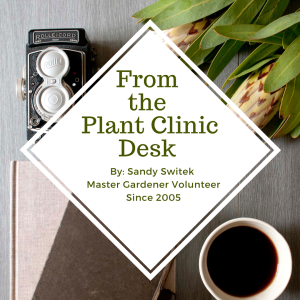Do we have spring bulbs in Florida?
Well, not if you mean crocus, tulips, daffodils, and hyacinths; our winters are not cold enough for them to survive here. But, if you want something big and showy that can return every spring and live for years, then just plant the right bulbs for our climate. In fact, some of these are blooming right now.
What is in bloom in the Spring?
- Easter Lily – Probably the most well-known. This is the time to possibly rescue one or two of them as soon as churches take them off of display. This lily can live in your yard as a perennial if given proper conditions. Just plant in a well drained sunny location after the blooms have faded. Feed and water as needed, and cut to the ground after all of the greenery has died down.
- Amaryllis – Another well known bulb. which garden centers usually sell as a potted plant. However, this plant is not limited to indoor use either. In Florida, it can be a nice addition to your garden with its large colorful blooms.
- Crinum bulbs – This one is similar to amaryllis, crinum bulbs are less common in stores, but still abundant in gardens. Apparently they are passed along from one gardener to another as they grow and multiply. Without a store label, it can be difficult to tell whether you have a crinum or an amaryllis, but both are in the Amaryllis family. The amaryllis does well as a potted plant or an outdoor plant, and generally has smaller bulbs and leaves than a crinum does. The crinum can easily outgrow a 6″ pot in a few years as the bulb grows and can ultimately weigh up to 20 pounds. While the Amaryllis has the reputation for being the most showy, the crinum is no wallflower. However, its size does make it ideal for being outdoors in the garden, as leaves can grow up to 6′ long. Its flowers are not larger than amaryllis blooms, even though its overall size is larger. The crinum was often called a Cemetery plant in Florida, due to its ability to survive with little or no care for many years. Its large bulbs store food and water for use during drought, heat, and cold weather.
Care Basics
- If you buy or inherit either of these bulbs, an ideal location would be an area of part shade or light high shade. However, anything but dense shade can be tolerated.
- Place them somewhere where toxic-plant-eating pets won’t get them.
- Plant the bulb with its neck slightly above the ground in well drained soil with plenty of organic matter.
- Water your plant until established.
- Feed 3 times a year.
- Once established, crinum is quite drought tolerant, even though it is also capable of growing in a wetland.
- In the garden, it is good to remove bloom stalks before seed formation. This will improve the plant’s blooming ability the following year.
Do we have Florida Natives?
There are native crinums called Swamp Lilies and Spider Lilies. The spider lily has a thin white bloom resembling a spider. All crinum blooms first appear in the spring and can also reappear in summer. Amaryllis is usually only a spring bloomer.
Watch for pest!
As for hazards, watch for those lubber grasshoppers on these plants, especially in the spring. Female lubbers sometimes choose them to lay their eggs next to. Also check for slugs under mulch. If present, they come out at night to create holes in leaves. Other than that, you can check for spider mites, red blotch fungus spots, and a virus which causes yellow leaf streaks. Normally these things don’t kill the plants.
We have a lot more!
Of course these are not the only bulb choices that we have.
- The Agapanthus is another plant in the Amaryllis family which makes an equally beautiful showing with its large mass of flowers. The blooms can be blue, lavender, purple, or white. Full sun is preferred, though part sun will do. Size is 2-4′.
- Other available bulbs are rain lilies, hurricane lilies, crocosmia, cannas, and more.
We are especially fortunate to be able to grow such large showy bulbs outside.
Here are a few of my own recent photos.
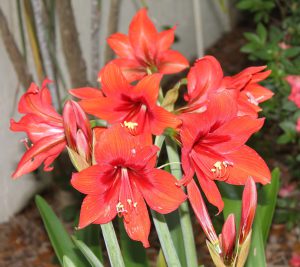 Crinum
Crinum
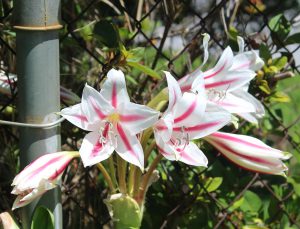 Crinum
Crinum
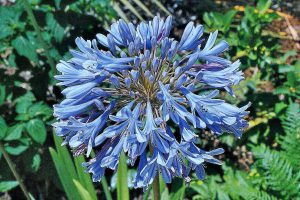 Blue agapanthus
Blue agapanthus
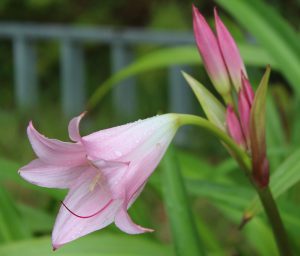 Pink crinum
Pink crinum
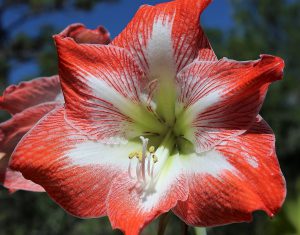 Amaryllis
Amaryllis
ALL PHOTOS BY SANDI SWITEK
Need more information:
For more information about Florida Friendly Plants you can email me at epabon5@ufl.edu or like us to learn about new classes or events at Gardening in Central Florida
By: Sandy Switek since 2005 and Eva Maria Pabon Residential Horticulture Agent
Do you want to read more about gardening? Follow our blog Eva Pabon, Author at UF/IFAS Extension Osceola County (ufl.edu)
 1
1
